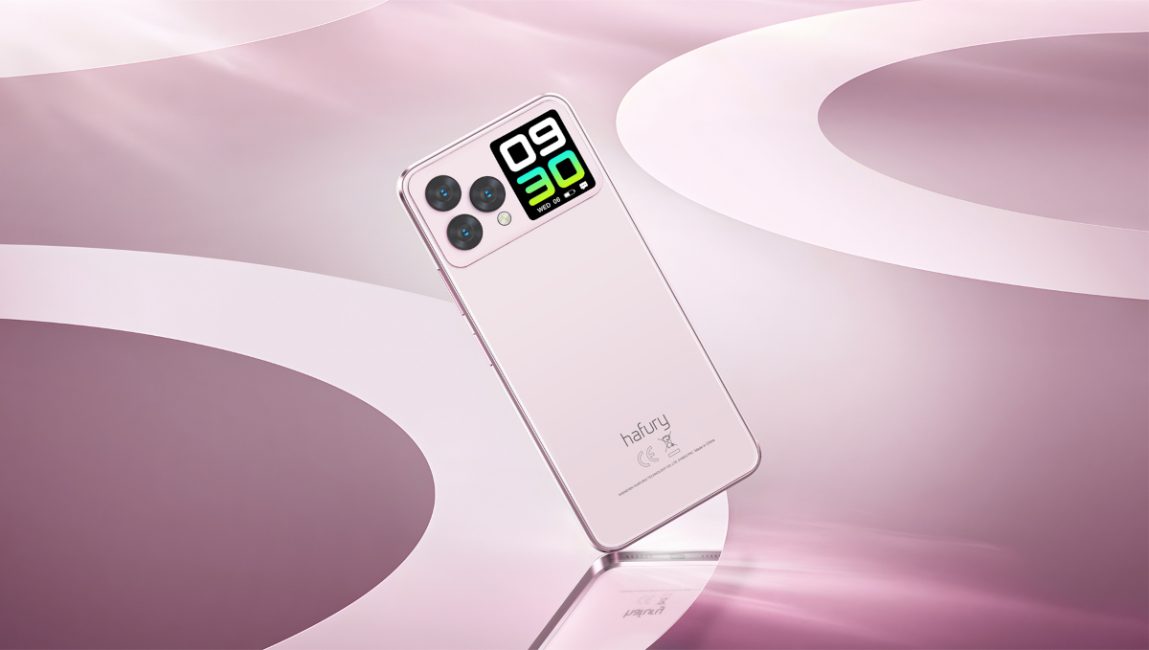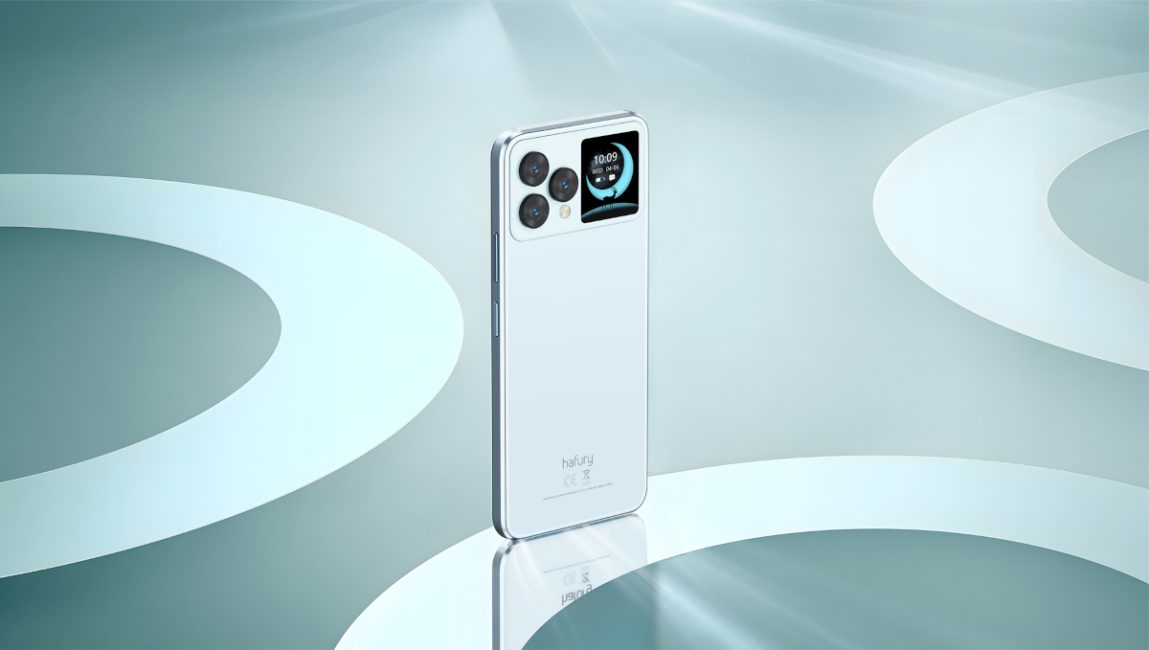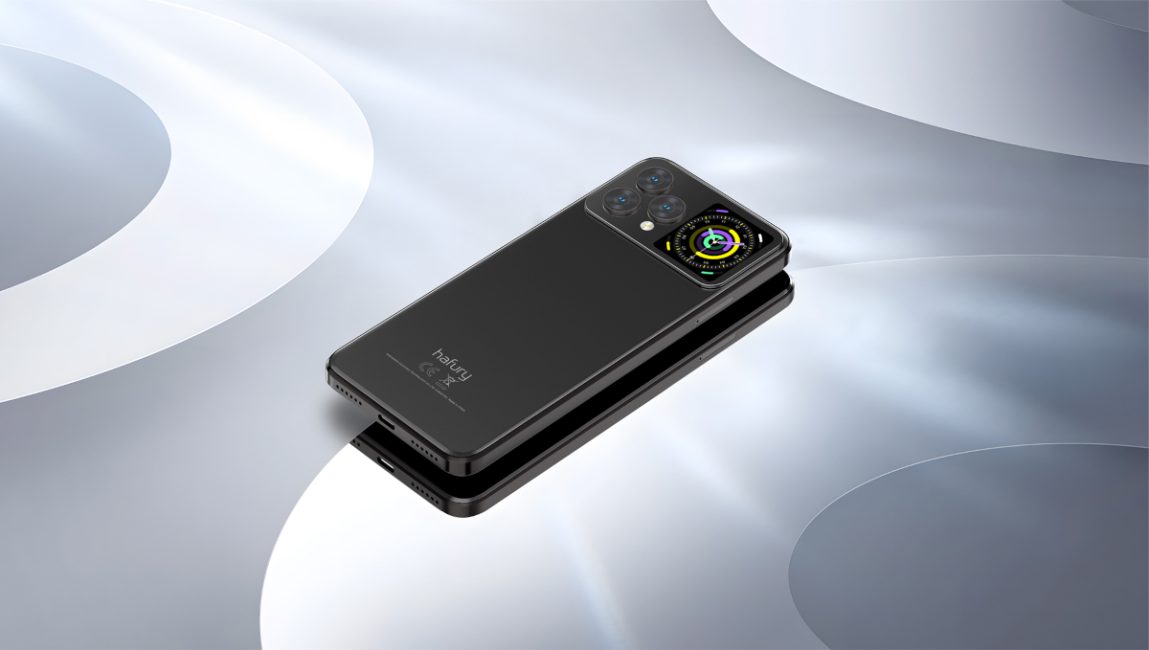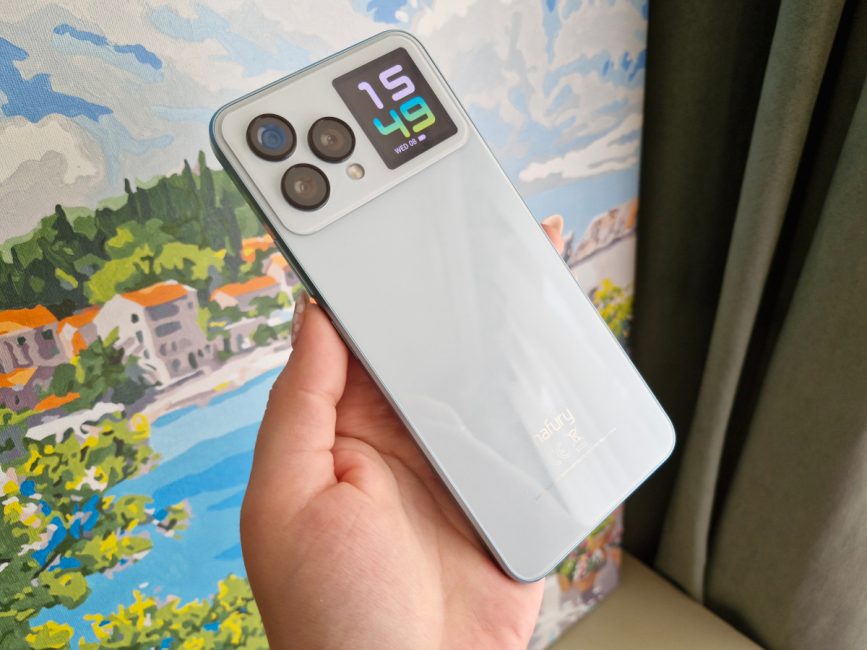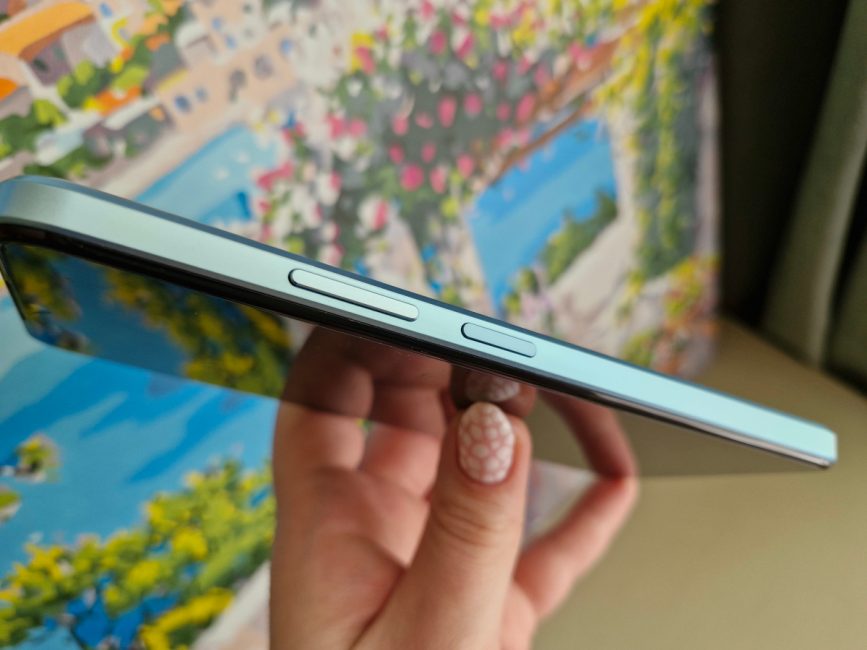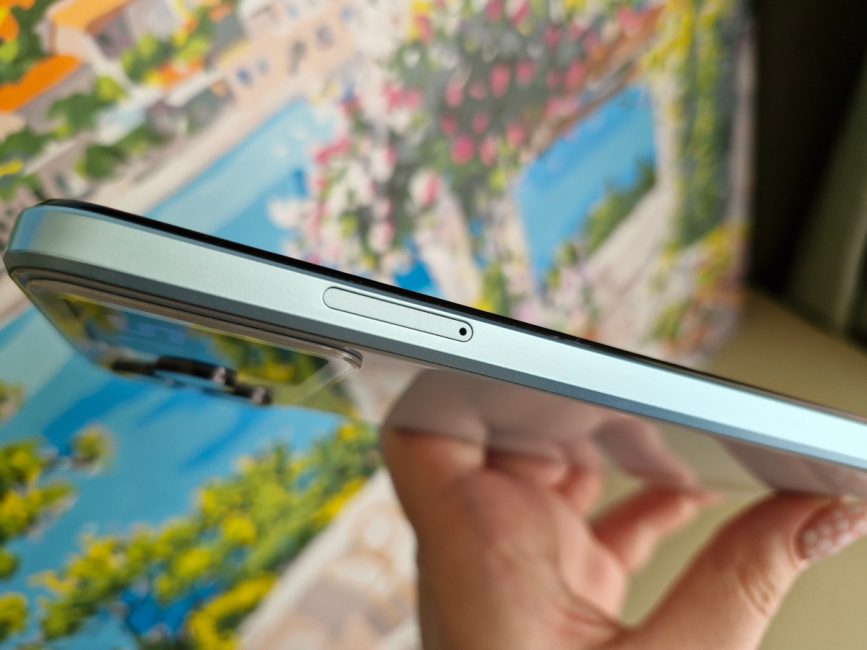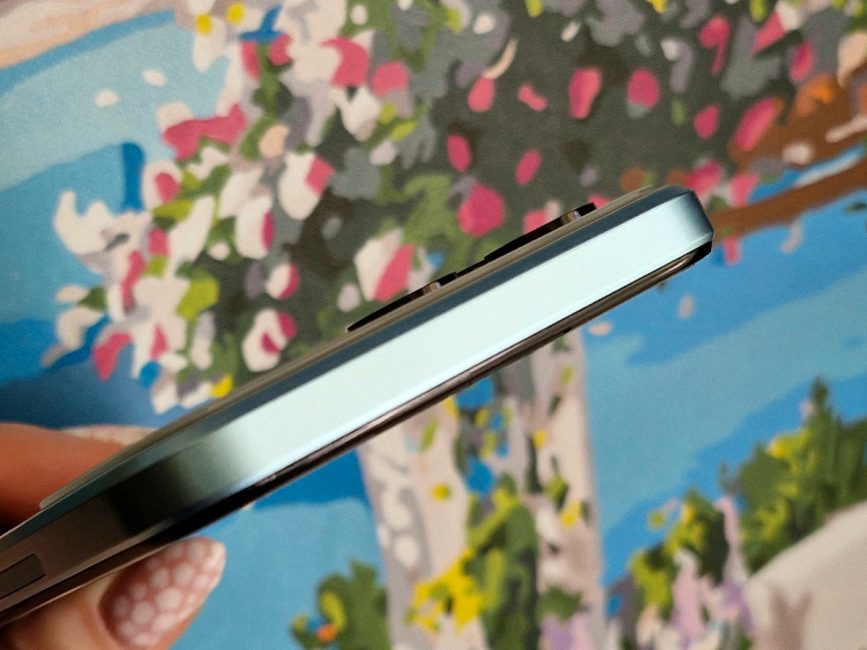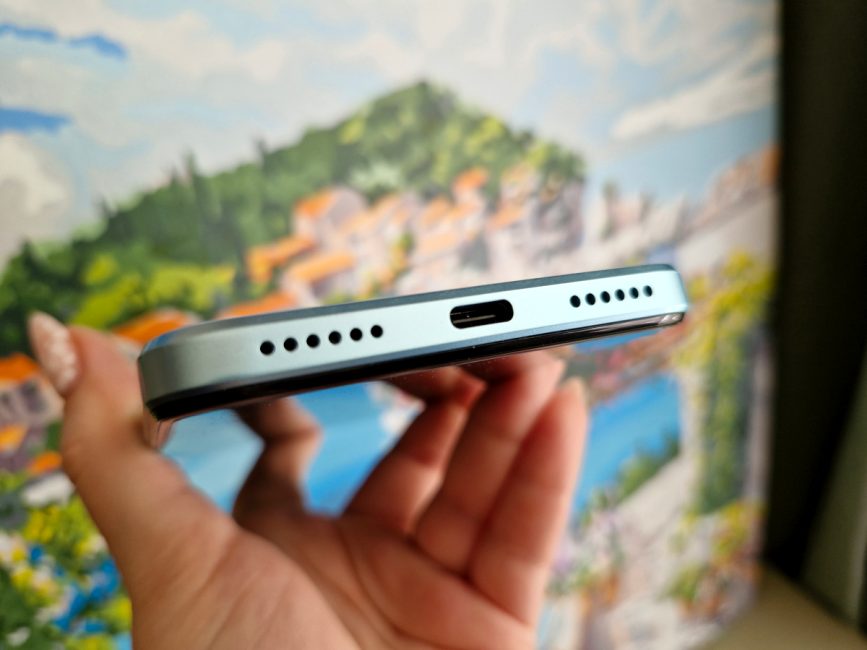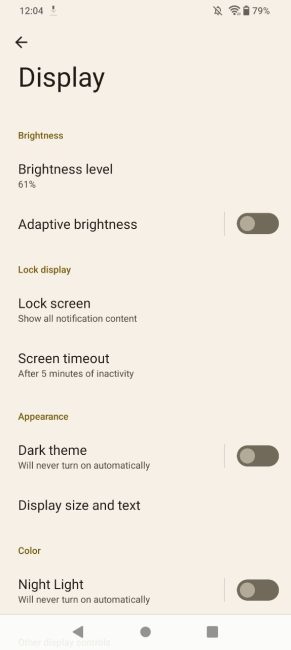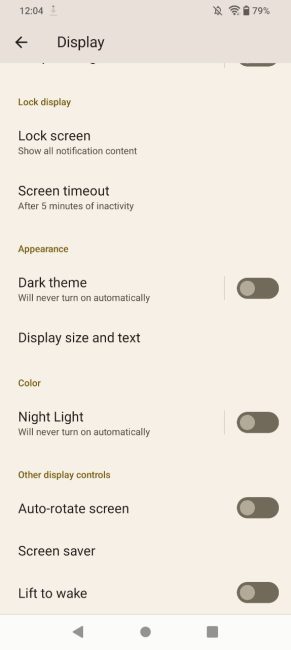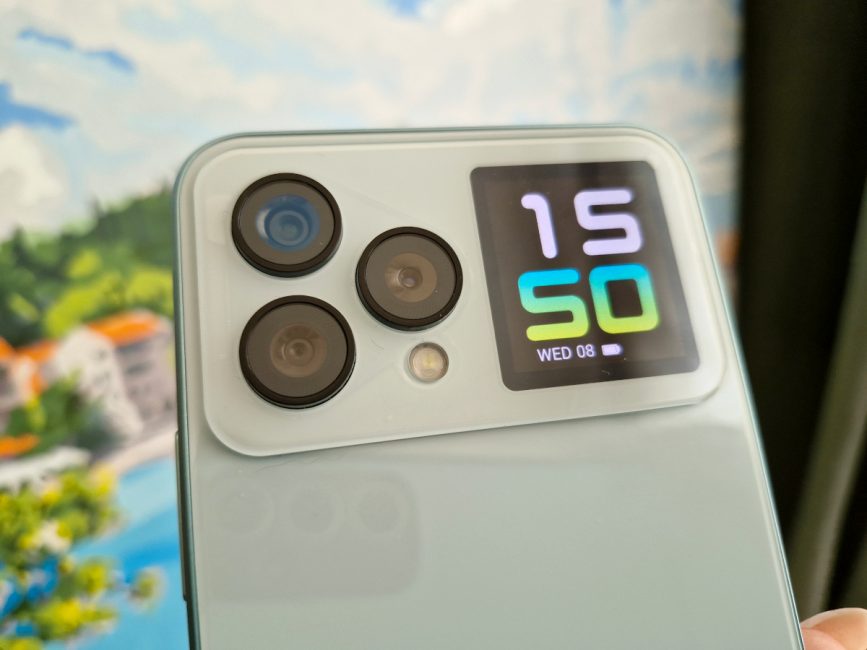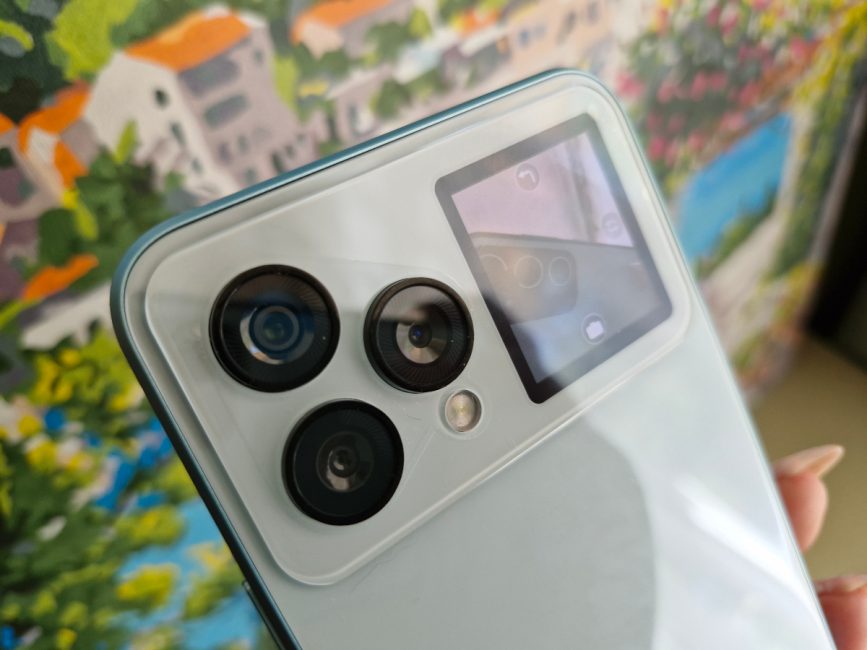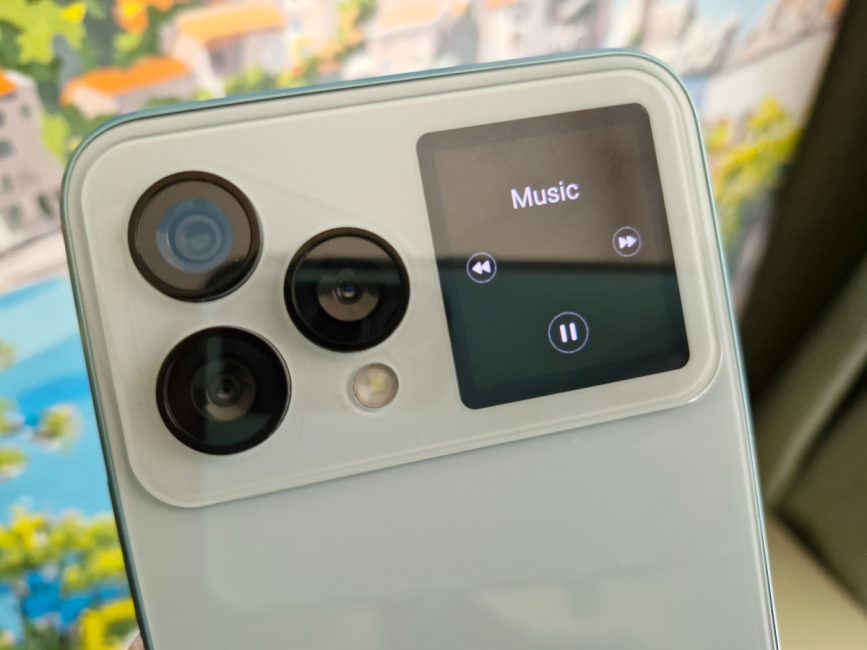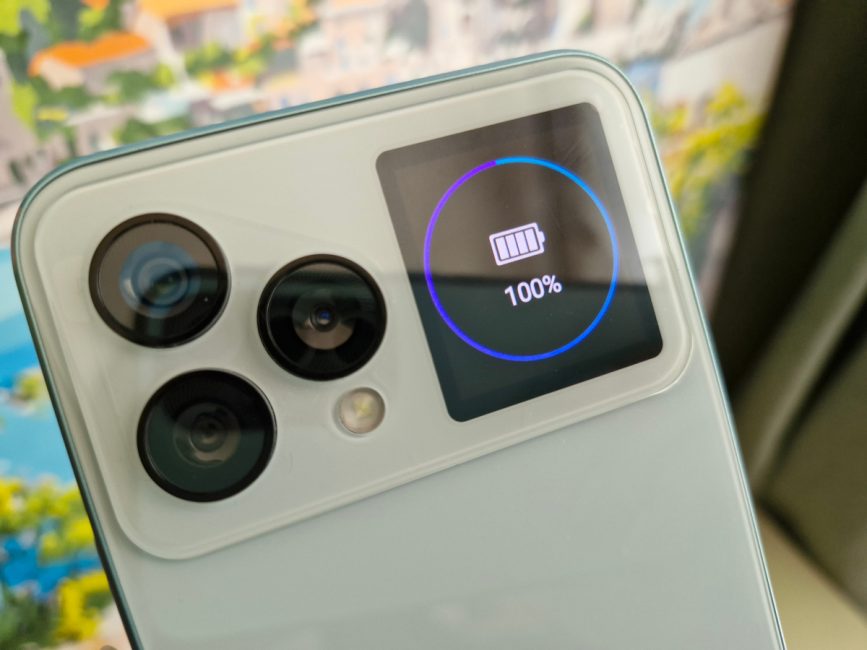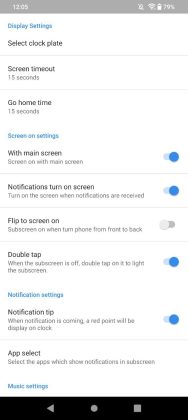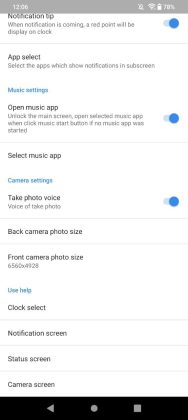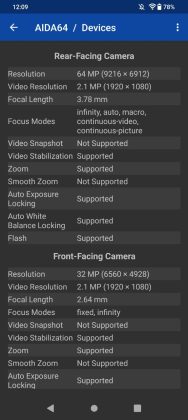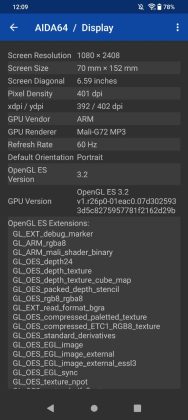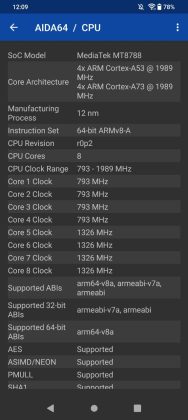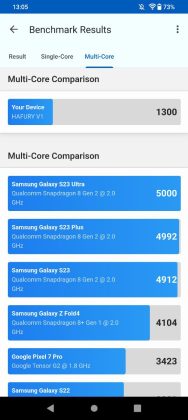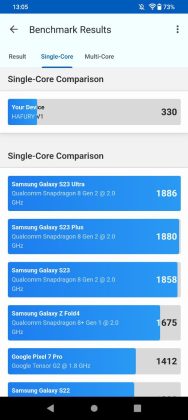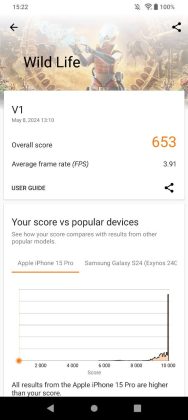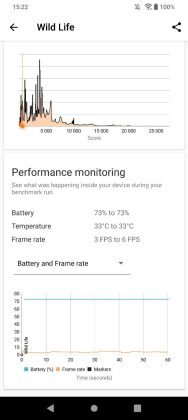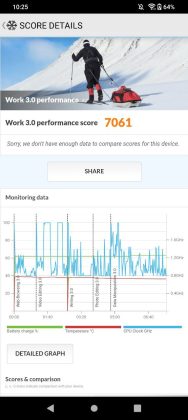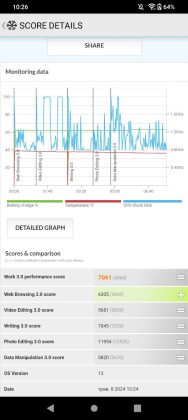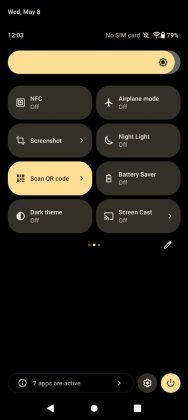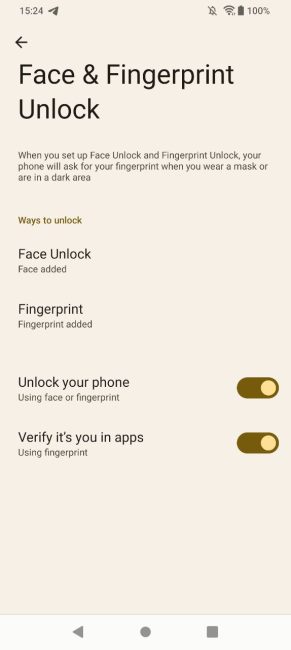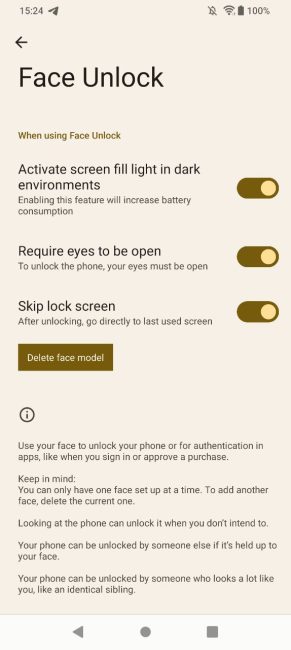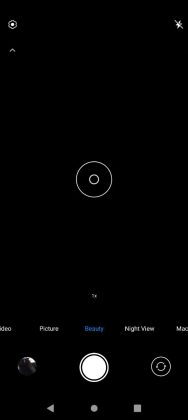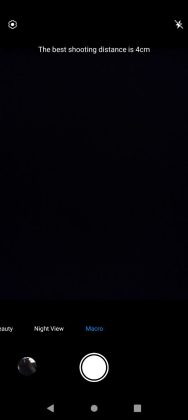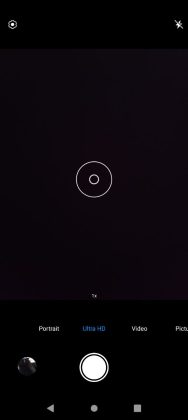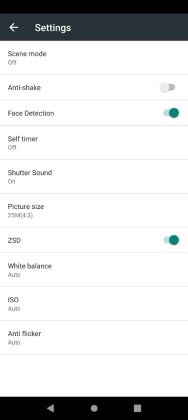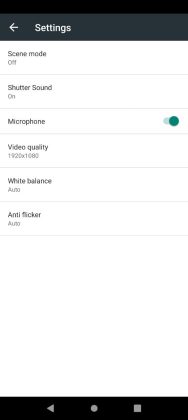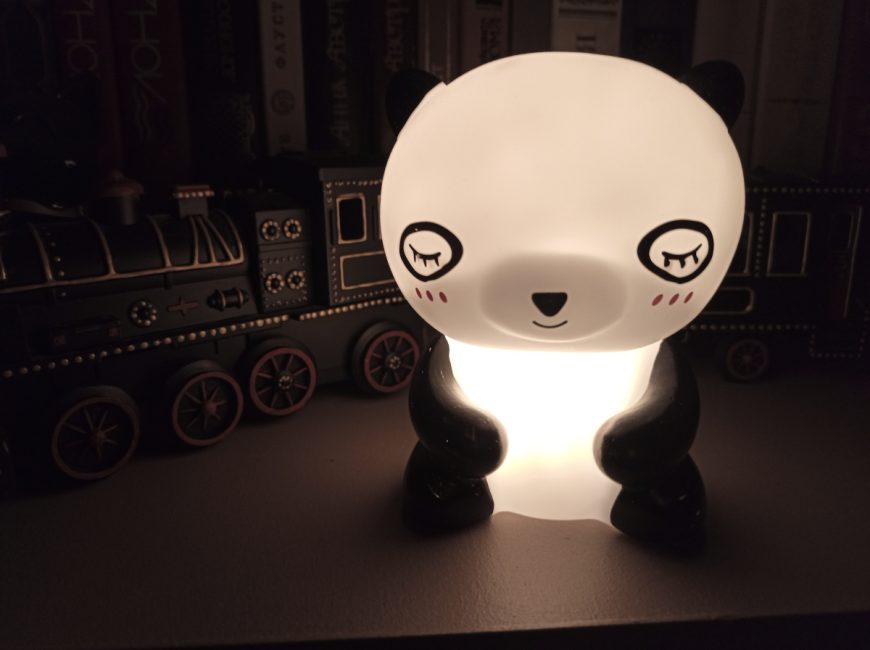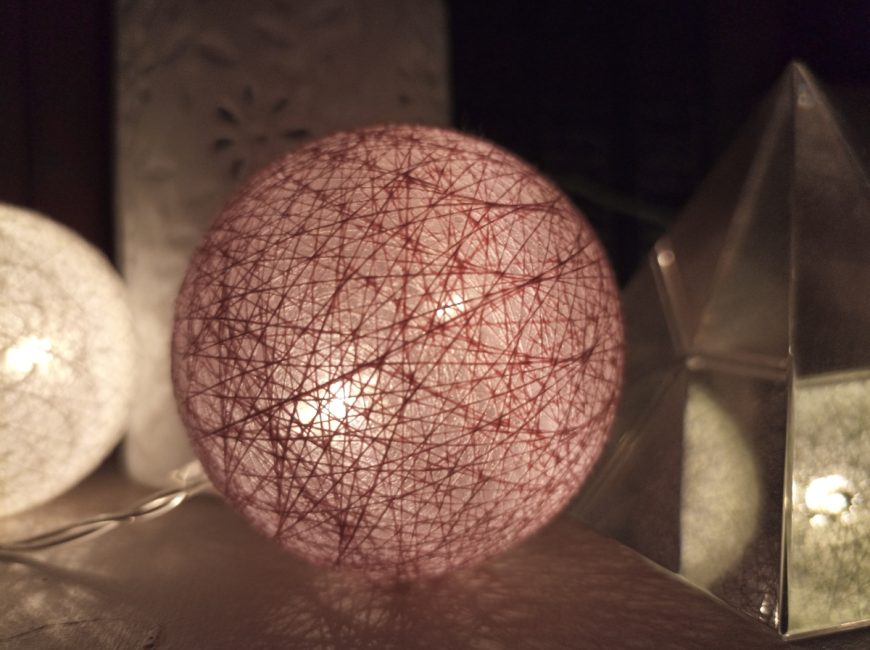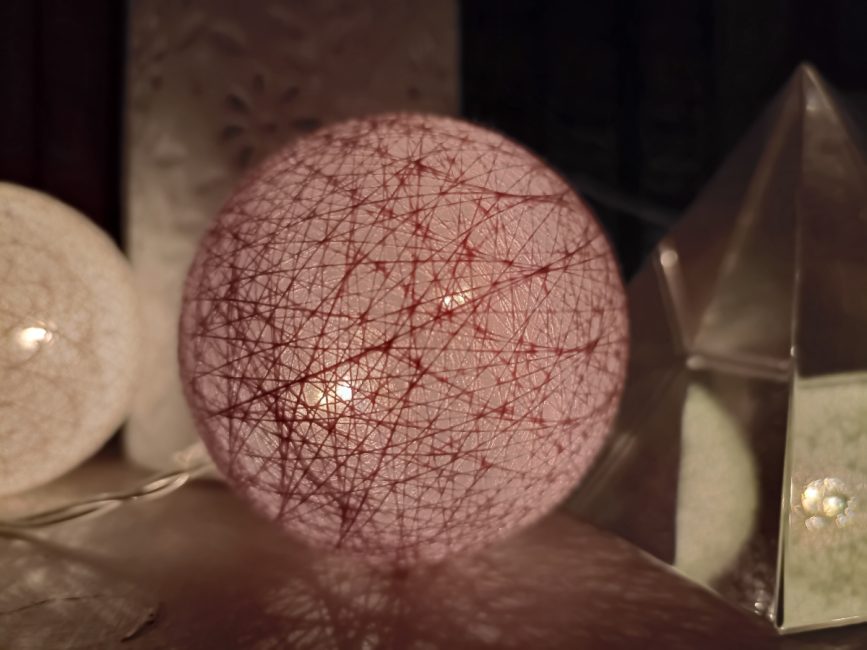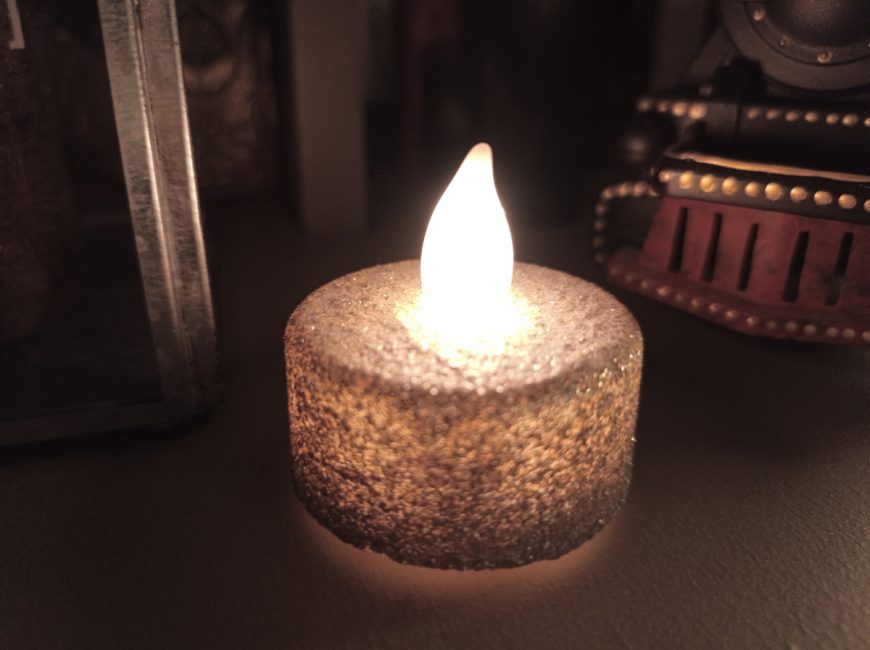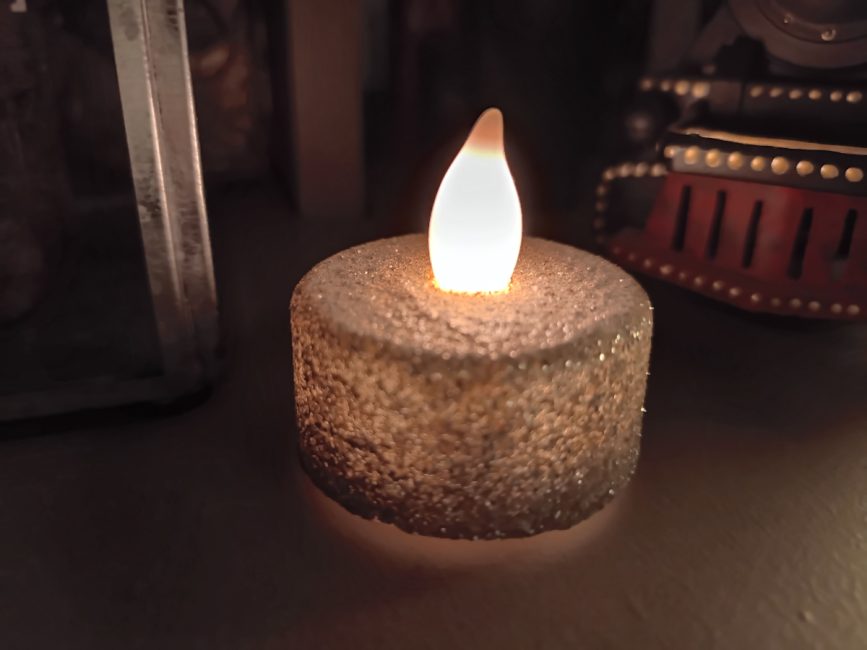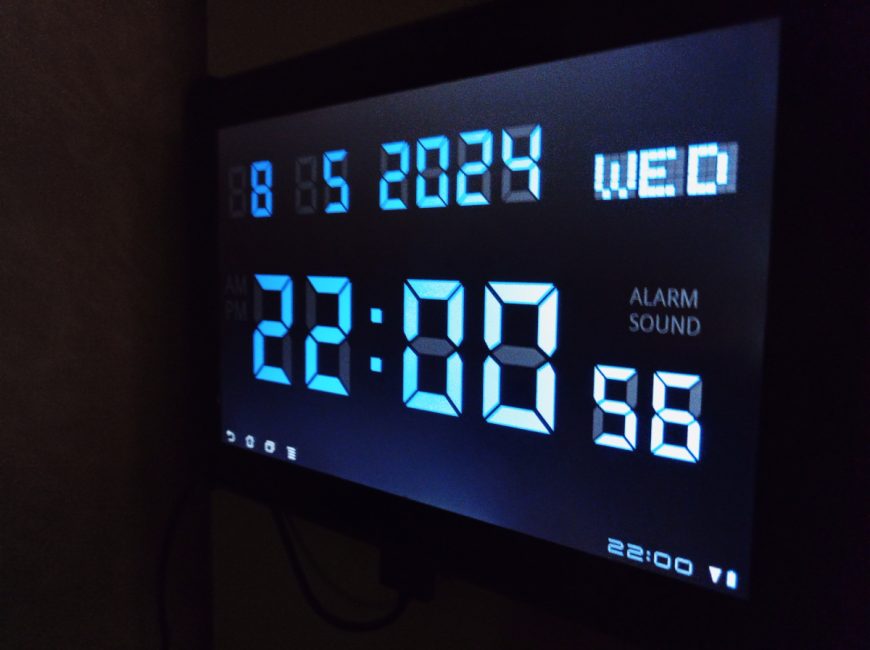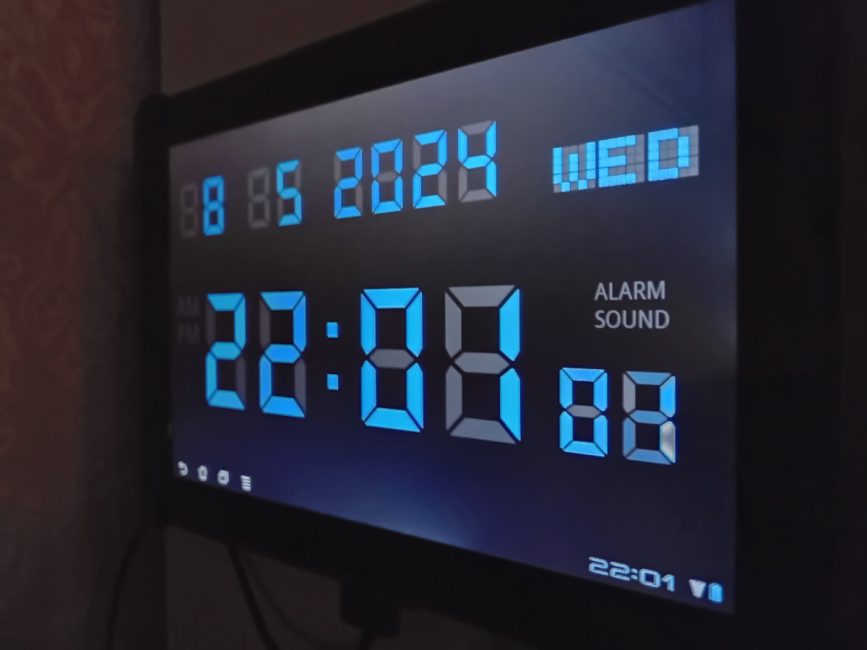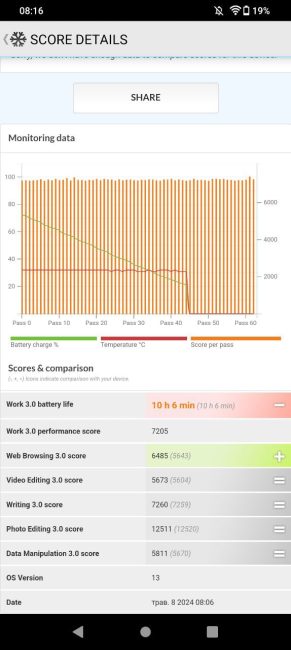Continuing our exploration of Hafury smartphones for women, today we’re looking at the Hafury V1. This affordable device’s main highlight is the presence of an additional screen on the back. The small AMOLED panel serves not only as a decoration or extra clock but can also be used for viewing notifications, controlling music, and taking higher-quality selfies with the main camera. What else does the Hafury V1 have to offer?
Read also:
Cubot Hafury V1 Specifications
- Displays: main display – IPS, 6.58″, FHD+ (1080×2408), 401 ppi; additional (rear) – AMOLED, 1.41″
- Processor: MediaTek MT8788, 8 cores, 4×Cortex-A53 (2.0 GHz) + 4×Cortex-A73 (2.0 GHz), 12 nm
- GPU: ARM Mali-G72
- Permanent memory: 256GB
- RAM: 8GB (+8GB due to ROM)
- Slot: combined, 2 nanoSIM or nanoSIM + microSD
- Wireless networks: Wi-Fi 5, Bluetooth 4.2, NFC, GPS, A-GPS, GLONASS, Galileo
- Main camera: 64MP + auxiliary 0.3MP + 2MP macro
- Front camera: 32 MP
- Battery: 4350 mAh, charging power 18W
- OS: Android 13
- Dimensions: 165.75×75.8×9.0 mm
- Weight: 200 g
- Additional: 2 cases included and strap, 3 case colors (Light blue, Pink, Black)
Positioning and price

Just like the Hafury Meet, the device is available for purchase in the official Hafury store on AliExpress, where it will cost you only about $145. Price-wise, it’s a classic budget option, but it has several interesting features (and it’s not just the package contents) that make it a quite intriguing smartphone in its category.
Hafury V1 package

The smartphone comes in the same box as the Hafury Meet, but with a slightly different set of accessories. Inside the square blue box with a magnetic latch, you can also find a blue-colored charger and cable (only for V1 with an 18W charger), a SIM card tray ejection tool, accompanying documentation, and two bumpers.
 One of the cases is transparent with a golden edge, but unlike the one included with the Meet, it is made of silicone rather than plastic. The other bumper is more glamorous – adorned with rhinestones, a pocket, and a decorative element shaped like a perfume bottle, which transforms into a stand for the smartphone and conceals a compact mirror underneath. It also comes with a strap so you can carry the device on your shoulder.
One of the cases is transparent with a golden edge, but unlike the one included with the Meet, it is made of silicone rather than plastic. The other bumper is more glamorous – adorned with rhinestones, a pocket, and a decorative element shaped like a perfume bottle, which transforms into a stand for the smartphone and conceals a compact mirror underneath. It also comes with a strap so you can carry the device on your shoulder.
I’ve already shared my opinion about the accessories in the Hafury Meet review, so I won’t repeat myself. Hafury V1 hasn’t forgotten about the factory film, and there’s also a protective glass included in the package. The package is very generous, simply 10 out of 10.
read also:
- Cubot Note 40 Review : What to expect from a budget smartphone
- Cubot Note 50 Smartphone Review: Worthy of your attention
Design, materials and arrangement of elements
 Comparing the appearance of Hafury V1 and Meet, the former has a more minimalist design.
Comparing the appearance of Hafury V1 and Meet, the former has a more minimalist design.
The model comes in a plastic body and in three colors: blue, as seen in the review, as well as pink and black. The smartphone has a rather simplistic design, with straight edges and no “curved” screen.
The back of the chassis is simply blue and covered with a transparent plastic panel, which visually resembles glass. It’s glossy and, as expected, accumulates all traces of use quite easily. There are no special decorative elements on it like on the Meet, and the technical branding with the brand name is also applied to the bottom part. However, attention is drawn to the camera block.
At the back you can see a low rectangular “step”, on which there is a triple camera module, a flash and an additional square display. It is touchscreen and quite functional, but we’ll talk more about its features and characteristics below. However, it is this mini-screen that became the main decoration and design feature of Hafury V1.

On the front, we see the main screen with quite noticeable bezels (the screen-to-body ratio is 83%) and a prominent “chin,” as well as a teardrop-shaped notch for the front camera. At the junction of the screen and the top edge, you can see the earpiece grille.
 The edges here are flat, plastic, painted to match the color of the case, but have a metallic texture. To the left of the screen you can notice a slot for a pair of nanoSIM or one SIM and a memory card. On the opposite side there are, as usual, volume and power buttons, which is combined with the fingerprint scanner.
The edges here are flat, plastic, painted to match the color of the case, but have a metallic texture. To the left of the screen you can notice a slot for a pair of nanoSIM or one SIM and a memory card. On the opposite side there are, as usual, volume and power buttons, which is combined with the fingerprint scanner.
The top edge is left empty, while at the bottom, you can see the USB Type-C port and symmetrical grilles on either side of it. There is only one main speaker here, located on the right, while on the left, they likely added a similar grille for symmetry. And, of course, there is the microphone for calls, as there are no other openings on the body. However, a 3.5mm audio jack is not provided.
Ergonomics
In terms of technical operation, it’s difficult to highlight anything original about the Hafury V1. Interacting with it is similar to most modern devices with a 6.58-inch screen. Thanks to its flat edges and elongated 20:9 aspect ratio, the smartphone fits well in the hand and doesn’t slip easily. The fingerprint scanner is positioned in the middle, making it easy to reach with the index finger of the right hand. For one-handed use, it’s better to use the corresponding mode in the settings, as it’s impossible to reach the entire screen with one thumb. In short, it’s a fairly typical device for 2024, so the ergonomics of the V1 are good.

Displays
It’s not often in smartphone reviews that we have to use the word “screen” in the plural form. But this is precisely that case because in the Hafury V1, there are two of them.
 The main display here is an IPS panel with a diagonal of 6.58 inches, FHD+ resolution (1080×2408), and a pixel density of 401 ppi. The base refresh rate is 60 Hz. The screen boasts a good brightness reserve, which maintains readability even in direct sunlight, as well as excellent viewing angles and natural color reproduction. Unfortunately, you can’t change it — in the settings, the useful options are limited to only a dark theme, night mode, auto-brightness, and customization of the interface appearance and wallpapers.
The main display here is an IPS panel with a diagonal of 6.58 inches, FHD+ resolution (1080×2408), and a pixel density of 401 ppi. The base refresh rate is 60 Hz. The screen boasts a good brightness reserve, which maintains readability even in direct sunlight, as well as excellent viewing angles and natural color reproduction. Unfortunately, you can’t change it — in the settings, the useful options are limited to only a dark theme, night mode, auto-brightness, and customization of the interface appearance and wallpapers.
The additional display in the Hafury V1 is an AMOLED panel with a diagonal of 1.41 inches. It features multiple screens, and overall interaction with it resembles that of a smartwatch. The first “desktop” is the clock, the appearance of which can be customized in the MiniScreen menu. This is followed by the camera app, which allows you to take selfies with the main module, as well as a music player. Swiping down reveals the remaining battery charge, while swiping up shows notifications from various apps and messengers.
Actually, they did try to make the bonus of the additional display useful. But let’s think about how much demand it will have in everyday life. In my opinion, the most useful function is the ability to take selfies with the main module using the screen as a “viewfinder.” The other features simply duplicate what can be seen on the main screen, and, let’s be honest, reading notifications on a larger display is more convenient. During testing, I hardly used it, except for the first few days, because the feature itself is interesting. But then I simply forgot about it, using the smartphone in the classic way. Although, perhaps it’s a matter of habit, and for someone, the additional screen will be a truly relevant option for everyday use.
Read also:
- Cubot Kingkong Power smartphone review: unbreakable powerbank with torch
- Cubot Note 21 smartphone review
Hardware and wireless connections
 The Hafury V1 is equipped with a 12nm octa-core MediaTek MT8788 processor. Half of the cores are Cortex-A53 with a clock speed of around 2.0 GHz, while the remaining 4 are Cortex-A73 with a similar frequency. The ARM Mali-G72 handles graphics processing. The smartphone’s configuration is unique, offering 256 GB of internal storage with microSD expansion up to 1 TB and 8 GB of RAM with support for the Memory Expansion feature, allowing for an additional 8 GB of virtual RAM. Among the wireless networks supported are Wi-Fi 5, Bluetooth 4.2, NFC, and location services.
The Hafury V1 is equipped with a 12nm octa-core MediaTek MT8788 processor. Half of the cores are Cortex-A53 with a clock speed of around 2.0 GHz, while the remaining 4 are Cortex-A73 with a similar frequency. The ARM Mali-G72 handles graphics processing. The smartphone’s configuration is unique, offering 256 GB of internal storage with microSD expansion up to 1 TB and 8 GB of RAM with support for the Memory Expansion feature, allowing for an additional 8 GB of virtual RAM. Among the wireless networks supported are Wi-Fi 5, Bluetooth 4.2, NFC, and location services.
For everyday tasks, the performance of the Hafury V1 is quite adequate. Working with popular applications such as messengers, search engines, online banking, and multitasking, as well as simple games, should pose no problems. Of course, considering its specifications, it’s not designed for heavy gaming, but for everyday use, the smartphone won’t disappoint. You can find the results of synthetic tests below.
Hafury V1 Software
 Just like the Hafury Meet, the V1 runs on “pure” Android 13. The interface is devoid of additional “overlays” (it uses classic Google apps), so it’s quite simple, understandable, and fairly speedy. The smartphone has basic functionality, and apart from the menu for working with the additional screen, there’s hardly anything special here to grab your attention.
Just like the Hafury Meet, the V1 runs on “pure” Android 13. The interface is devoid of additional “overlays” (it uses classic Google apps), so it’s quite simple, understandable, and fairly speedy. The smartphone has basic functionality, and apart from the menu for working with the additional screen, there’s hardly anything special here to grab your attention.
Unlocking methods
 The Hafury V1 features the classic combination of a fingerprint scanner, located on the side within the power button, and facial recognition. Both options work well—quickly and accurately (during testing, no issues arose). The facial scanner manages to unlock even in low-light conditions when the screen brightness is low. To enable this, you need to activate the temporary brightness boost feature in the settings, as it’s turned off by default. This is a feature that was missing in the Meet model.
The Hafury V1 features the classic combination of a fingerprint scanner, located on the side within the power button, and facial recognition. Both options work well—quickly and accurately (during testing, no issues arose). The facial scanner manages to unlock even in low-light conditions when the screen brightness is low. To enable this, you need to activate the temporary brightness boost feature in the settings, as it’s turned off by default. This is a feature that was missing in the Meet model.
Read also:
Sound

Interestingly, the Hafury V1 attempted to create stereo sound. Here, the main lower speaker is complemented by the earpiece speaker. Of course, it’s noticeably quieter and produces a flatter sound, but overall, the sound becomes more engaging and slightly spacious. In portrait orientation, it performs decently, but in landscape mode, the advantage of the lower speaker is evident. Overall, for social media feeds, the sound is pleasant, but it lacks balance for YouTube, for instance. Headphones come in handy here. However, it’s worth noting that you can only connect Bluetooth headphones to the Hafury V1 or use a Type-C to 3.5mm adapter since there’s no audio jack here.
Hafury V1 cameras

The rear camera consists of 3 modules: a main 64 MP sensor, accompanied by a 0.3 MP depth sensor, and a modest 2 MP macro lens. Video is captured in Full HD resolution, and optical stabilization is notably absent.
Looking at the camera app, everything is quite modest, but the essentials are there. There’s only one mode for video, and for photos, there are Portrait, Ultra HD (64 MP), Picture (standard), Beauty, Night, and Macro options.
What can be said about the quality of photos from the main camera? As is common in modern smartphones, the standard shooting mode captures images at 16 MP resolution, as V1 uses Quad Pixel 4-in-1 pixel binning. To get good shots, Hafury V1’s best friend is good (ideally, natural) light. With it during the day, you can take pleasant photos – detailed, sharp, and contrasty. In low light conditions, the quality of the shots naturally decreases, but the night mode comes to the rescue. Here, it works better than on the Hafury Meet. In any case, the difference is more noticeable. Here are a few illustrative examples (night mode on the right).
And a few more example photos in different lighting.
As for the macro camera, it’s quite basic and very sensitive to light in Hafury V1. If needed, you can capture textures or small details, but you shouldn’t expect anything extraordinary from the 2 MP module.
The front camera here is 32 MP. There are only 3 shooting modes: Video (maximum resolution HD), Image, and Beauty. In good daylight conditions, selfies turn out quite pleasant: detailed, clear, with nice color reproduction and contrast. The beauty mode isn’t adjustable and provides an effect that’s very popular in Asia – eye enlargement and full skin blur. In short, for its class, the front camera is quite decent, and with some skill, it can be used not only for video calls.
Battery life
 The Hafury V1 is equipped with a 4350 mAh battery, and the charging power is 18 W. According to the manufacturer, a full charge will last up to 21 hours in talk time mode or up to 17 hours of music playback. Presumably, if we’re talking about operation with the screen off, these figures could be realistic. However, in the PCMark V1 battery test, it showed just over 10 hours with the screen on (brightness around 50%, only Wi-Fi enabled, all background apps closed). It’s not an impressive figure, but overall, the smartphone lasts for a day of use, which is ultimately the most important thing.
The Hafury V1 is equipped with a 4350 mAh battery, and the charging power is 18 W. According to the manufacturer, a full charge will last up to 21 hours in talk time mode or up to 17 hours of music playback. Presumably, if we’re talking about operation with the screen off, these figures could be realistic. However, in the PCMark V1 battery test, it showed just over 10 hours with the screen on (brightness around 50%, only Wi-Fi enabled, all background apps closed). It’s not an impressive figure, but overall, the smartphone lasts for a day of use, which is ultimately the most important thing.
Read also:
Conclusions and competitors

The Cubot Hafury V1 is a rather pleasant budget device for the undemanding user. Undoubtedly, the icing on the cake is the additional functional screen and the very nice accessories, but it can also be praised for its good main display, adequate performance, “clean” Android 13, and decent cameras and battery life for its class. Despite its positioning and accessories, the Hafury V1 has a quite understated design, so, in my opinion, it’s hard to categorize it strictly as a feminine smartphone.
Who will compete with the Hafury V1 in its niche? Of course, competitors won’t offer an additional screen or such a cool set of accessories, but in terms of specifications, there are many analogs to consider. For example, the Moto G24 Power. Priced at around $150, the smartphone offers a larger battery capacity and faster charging (6000 mAh, 30W), fresh and similarly “clean” Android 14, and a 3.5mm audio jack. However, its screen, although boasting a 90Hz refresh rate, only has an HD+ resolution.

You could also consider the Infinix Hot 40. It features a similar screen, but with a 90Hz refresh rate, a flash for the front camera, slightly larger battery capacity, and a 33W charging power. However, it comes with a weaker processor (Helio G88, 1.6 GHz).

The Poco C65, popular in many markets, would also be considered a competitor to the V1. It features a 90Hz refresh rate screen, a 3.5mm headphone jack, and a 5000mAh battery. Most specifications of the Poco model align with the Hafury V1, except for the HD+ display, which might not suit everyone’s preferences.

